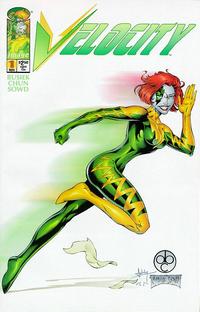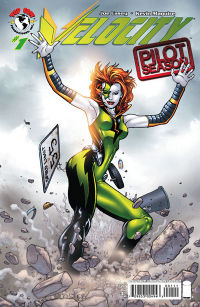 This weekend I read the 3-issue Velocity miniseries from 1995, by Kurt Busiek and Anthony Chun. I’m not terribly familiar with the character, having read only the Pilot Season one-shot from 2007. I haven’t read any Cyberforce or anything else she’s appeared in, since I basically ignored Image back in the 1990s. (I was a DC snob at the time, and only made exceptions for Groo the Wanderer and the occasional licensed book.)
This weekend I read the 3-issue Velocity miniseries from 1995, by Kurt Busiek and Anthony Chun. I’m not terribly familiar with the character, having read only the Pilot Season one-shot from 2007. I haven’t read any Cyberforce or anything else she’s appeared in, since I basically ignored Image back in the 1990s. (I was a DC snob at the time, and only made exceptions for Groo the Wanderer and the occasional licensed book.)
What struck me right away was that this was not the character I remembered from Pilot Season. This Velocity was shy, timid, and always followed her first instinct: to run away. I was also annoyed by the male/female protector/protected dynamic that started out with Heatwave (no relation) and shifted to Savage Dragon in issue #2. It’s one thing if your lead is the protector, but if your lead is the protected and supposed to be the hero?
I kept reading, though, and realized that this miniseries was about how Velocity grows up and becomes the capable hero I read in about in the Pilot Season book.
She’s put in a situation where she can’t just run away, and can’t rely on other people to shield her. She’s cornered, and has to turn and fight. Near the end of issue #2 she begins taking her fate into her own hands. By the end of the story, she leads her pursuer to a battleground more suited to her and defeats him on her own. More importantly, learns that she can.
Compared to the Flash
The emphasis on running away reminded me of Flash: Rebirth, which has made a point of characterizing Barry Allen’s life (unfairly, but he is depressed right now) as a series of choices from which he ran away. Both miniseries are about taking a character who is not ready to be a hero (Barry with his not-quite acknowledged death wish, Carin with her inability to overcome fear) and moving them to where they need to be in order to become better heroes.

 Visually I was reminded of a couple of DC speedsters, both of whom I suspect were in part modeled on Velocity’s look. Around the time this miniseries came out, Christina Alexandrova reappeared as an acolyte of Savitar, and had a lightning bolt painted on the right side of her face, very much like Velocity’s. And a decade later, in 52, Trajectory had a mostly-solid dark costume with a lighter-colored lightning bolt pointing down from her neck — again, very much like Velocity. (Plus, Trajectory was a teenage girl speedster on a journey to build confidence, like Velocity at this point in time.)
Visually I was reminded of a couple of DC speedsters, both of whom I suspect were in part modeled on Velocity’s look. Around the time this miniseries came out, Christina Alexandrova reappeared as an acolyte of Savitar, and had a lightning bolt painted on the right side of her face, very much like Velocity’s. And a decade later, in 52, Trajectory had a mostly-solid dark costume with a lighter-colored lightning bolt pointing down from her neck — again, very much like Velocity. (Plus, Trajectory was a teenage girl speedster on a journey to build confidence, like Velocity at this point in time.)
1990s Image Excess
The villain, Charnel, is not terribly interesting. Visually, he’s X-Treme Doomsday, with longer spikes. Personality-wise, he’s obsessed with killing people who have super powers, more or less just because. He does make a remark about testing people for worthiness to live at one point, but it rushes by so quickly that I’d forgotten it by the time I finished. Still, Charnel does what he needs to, which is to be is a threat who can’t be outrun, and who will make things worse if the hero goes for help.
Oddly, despite the fact that 1990s Image heroes are more likely to kill than DC heroes of any era (Kingdom Come was in many ways a reaction against the storytelling style and character types that made Image popular), judging by this book I’d have to say that today’s DC books are actually bloodier. I’m sure it’s just a matter of this particular book being less so.
On a related note, it’s always interesting to look at old house ads, particularly the ones for new characters who have since become well-established, like Witchblade. Of course, this is Top Cow, so there’s also an ad for Top Cow’s Secrets: Special Winter Lingerie Edition…
Returning to Pilot Season
 I also re-read the Joe Casey/Kevin Maguire Velocity: Pilot Season one-shot. By now, Carin has grown up and seems to be a seasoned pro. She starts out delivering an organ for a transplant (hmm, reminds me of the first issue of Wally West’s series) in the first few pages. This sets up the main story, which manages to balance a relatively simple, but well-structured hero-vs.-villain plot with a look at her personal life. (Check out CSBG’s review of the issue for more detail.) Also: Kevin Maguire draws fantastic facial expressions.
I also re-read the Joe Casey/Kevin Maguire Velocity: Pilot Season one-shot. By now, Carin has grown up and seems to be a seasoned pro. She starts out delivering an organ for a transplant (hmm, reminds me of the first issue of Wally West’s series) in the first few pages. This sets up the main story, which manages to balance a relatively simple, but well-structured hero-vs.-villain plot with a look at her personal life. (Check out CSBG’s review of the issue for more detail.) Also: Kevin Maguire draws fantastic facial expressions.
When I first read the book, it was my introduction to the character, and it did a perfectly good job as the proverbial new-reader-friendly book. Now, having read her previous miniseries, it’s interesting to see just how far she’s come.
It really is too bad the series ended up being canceled before it ever launched.
